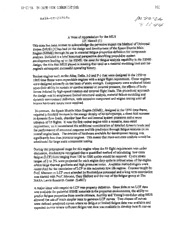
NASA Technical Reports Server (NTRS) 19960051096: A Note of Appreciation for the MUS PDF
Preview NASA Technical Reports Server (NTRS) 19960051096: A Note of Appreciation for the MUS
08-03-94 04:34PM FROMCOMMUNICATIONS P02 NASA-CR-20207C_ A Note ofAppreciationfortheMUS LF.Newell(I) ThisnotehasbeenwrittentoacknowledgethepervasiveimpacttheMethod ofUniversal SlopesCMUS) l'lh]ashadon thedesignanddevelopmentoftheSpaceShuttleMain Engine(SSME) throughitsuseinmaterialfatiguepropertiedsefinitiofnorcomponent analysisI.ncludedisabriefhistoricpaelrspectivedescribinpgropulsionsystem developmentleadingup totheSSME, theneedforfatigueanalysicsapabilitiyntheSSME design,therolethatMUS playedinmeetingthatneedasamaterialmodelingtoolandthe engine'ssubsequentsuccessfuolperatinghistory. Rocket enginessuchastheAtlas,Delta,J-2andF-Ithat were designedinthe1950to 1965timeframewere expendableengineswithasingleflighrtequirementT.hose engines were designedprimariloyn thebasisofstaticstrengthC.omponents were evaluatedbased upon theirabilittyosustainorsurviveinternaolrexternalpressuret,heeffectosfbody forcesinducedby high-speedrotationandexternalflighltoads.The proceduralapproach fordesignwas tosupplementlimitedstructuraalnalysism,aterialfailurmeodelingand dynamicenvironmentdefinitiowni,thextensivecomponent andenginetestinugntilall known hardwareissueswere resolved. Incontrastt,heSpaceShuttleMain Engine(SSME), designedinthe1970timeframe, requiredafourfoldincreaseintheenergydensityof'ittsurbopumps,athreefoldincrease indynamicflowloads,chamber heatfluxandinternaslystempressuresandareuse criterion of 55 flights. It was the first rocket engine with a reusable, man-rated requirement, so it necessitated the additional consideration of detailed dynamic loads and the performance of structural response and llfe prediction through fatigue analysis on an overall engine basis. The amount of hardware available for development testing was significantly less 1hun previous engines. This meant that more accurate analysis would be substituted for large scale component testing. During the preproposal stage for this engine when the 55 flight requirement was under discussion, Rocketdyne recognized that a quantified method of calculating low cycle fatigue (LCF) lives ranging from 100 to 1000 cycles would be required, Cyclic strain ranges of 2 to 3% were projected for each engine duty cycle in critical areas of the engine where large thermal gradients and high pressures occur. Available methodologies were researchedforthecalculatioonfLCF inthisextremelylowliferegime.Coursestaughtby Prof.Manson onLCF wereattendedby Rocketdynepersonnelandalongtermassociation was startedwithProf.Mznson, Om'yHalfordandtherestofthefatiguegroupatThe NASA LewisResearchCenter (LeKC). A major issue with respect to LCF was property definition. Since little or no LCF data was available for potential SSM2 materials inthe projected environments, the ability to predict fatigue properties from tensile ultimate, ductility and Young's modulus using MUS allowedtheuseofmuch simplerteststogenerateLCF curves.Two classesofcurves were defined: predicted curves where no fatigue or limited fatigue data was available and expected curves where sufficient fatigue test data was available to develop best fit curves. (18-03-94 04:34PM FROMCO_UNICATIONS P03 The SSME _alysis approach was to use design minimum properties From smooth specimens and local stress0s and strains predicted from detail hardware anaiysis to calculate component damage. The inform_ion from Manson's work in [1] and [2] on comparing Mug to LCF test results for a large number of'materials was used as abasis for determining a life factor of 3 for adjusting the Mug curve c_culations to develop prcdictod minimum curves, The SSIV_ was designed predominantly through the use of these predicted minimum curves since the design and a major part of the development effort was completed prior to the availability of confirming fatigue tests. Additional life reduction factors, such as the 10% rule [3], were utilized when high temperature effects such as creep interactions were present. When direct material test results are available, expected minimum design curves are d_eloped using a life reduction factor of 2 from typical in conjunction with additional data coverage criteria. Checks are also made of the design curves to insure that they are consistent with the physical metallurgical knowledge available for the particular material or material class at temperature. When the confirming fatigue tests were completed for SSME materials, very few of the predicted minimum fatigue curves had to be lowered, which confirmed the conservative nature of the implemented design approach using the MUS. The SSME uses a variety of high strength nickel base alloys, iron based alloys, aluminum castings, titaniums and copper alloys. The environments range from temperatures of-420F to 1800F and hydrogen pressures greater than 5000 psi in major areas of the engine. The primary concern with the high pressure hydrogen environment isthat it causes embrittlement in many materials that operate at room temperature during plastic straining of the material. The MUS was utilized by P,oekctdyne for the full gamut of environments and engine conditions listed above. The actual engine use based on the design analysis criteria and the MUS based properties resulted in minimal engine problems attributable to these methodologies. The MUS based design methodology was instrumental to the successful design and development of the SSMI/and crucial to the production of a highly reliable propulsion system meeting imposed time and cost constraints. Re£ 1)Manson, S. S., "Fatigue: A Complex Subject - Some Simple Approximations', Experimental Meehanics,p. 193-226, (July 1965) 2) Manson, S .S., Thermal Stress and Low-Cycle Fatigue, McGraw Hill, (1966) 3. Manson, S. S., "Interfaces Between Fatigue, Creep and Fracture,," International Journal of Fracture Mechanics, Vol. 2, No. 1, p. 327-363, 1966. (1) Chief Scientist Structural Analysis Rocketdyne Divison Rockwell International
